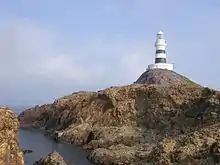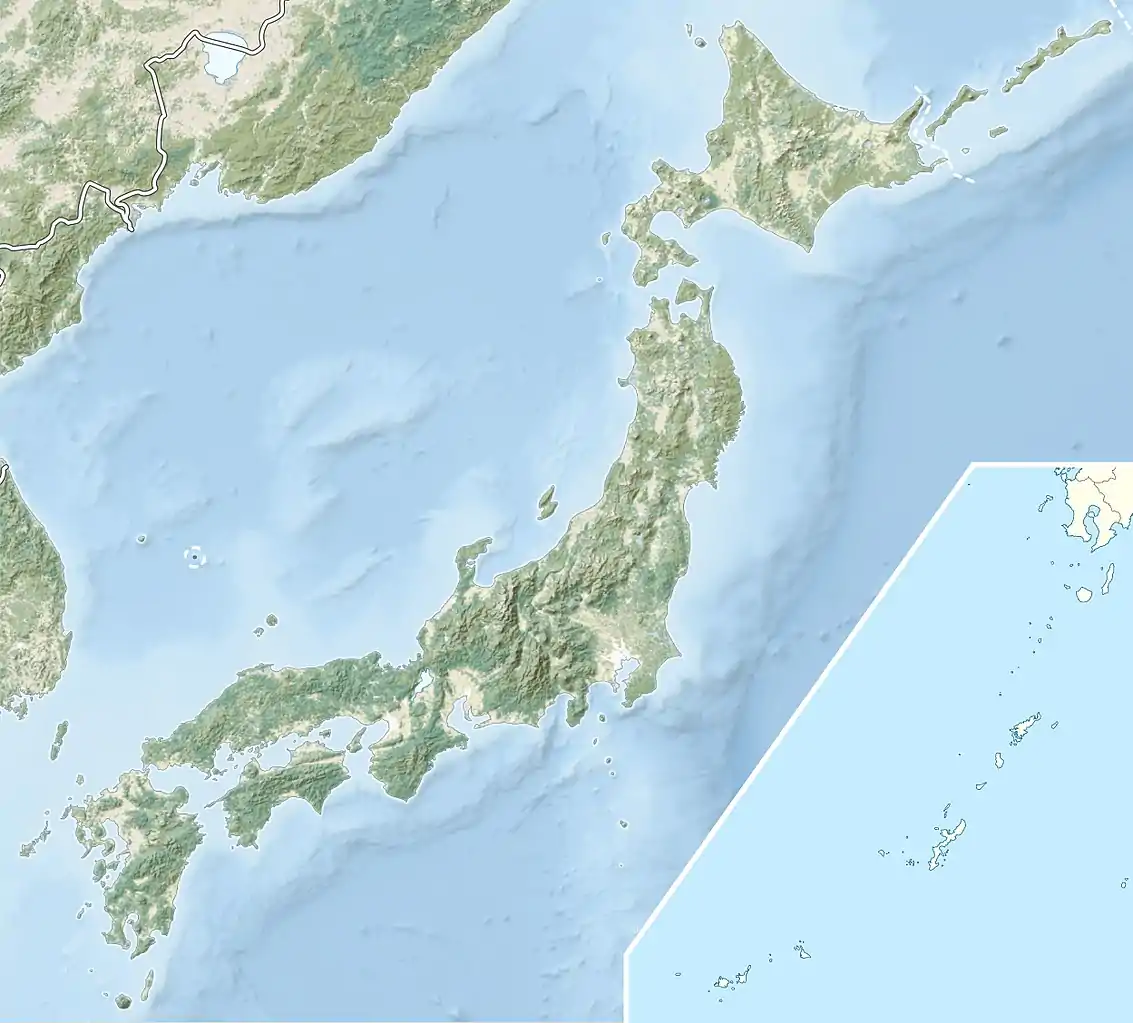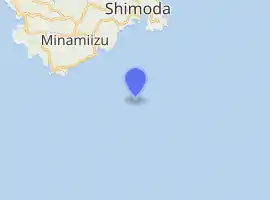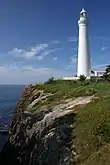Mikomotoshima Lighthouse
Mikomotojima Lighthouse (神子元島灯台, Mikomotojima tōdai) is a lighthouse located on Mikomotojima, a small (0.1 km2) uninhabited islet located 11 kilometres (5.9 nmi) south of Shimoda port, Shizuoka Prefecture, Japan.The site was designated a National Historic Site in 1937.[2]
 Mikomotojima Lighthouse | |
 Mikomotojima Lighthouse  Mikomotoshima Lighthouse (Japan) | |

| |
| Location | S of Shimoda Shizuoka Prefecture, Japan |
|---|---|
| Coordinates | 34°34′31.3″N 138°56′30.1″E |
| Year first constructed | 1871 |
| Foundation | brick and concrete |
| Construction | brick and concrete tower |
| Tower shape | tapered cylindrical tower with gallery and lantern |
| Markings / pattern | white and black bands tower, white lantern |
| Tower height | 23.3 metres (76 ft) |
| Focal height | 51 metres (167 ft) |
| Original lens | Third Order Fresnel |
| Range | 19.5 nautical miles (36.1 km; 22.4 mi) |
| Characteristic | Fl (2) W 16s. |
| Admiralty number | M6290 |
| NGA number | 5548 |
| ARLHS number | JPN-353 |
| Japan number | JCG-2447[1] |
History
The Mikomotojima Lighthouse was one of eight lighthouses to be built in Meiji period Japan under the provisions of the Anglo-Japanese Treaty of Amity and Commerce of 1858, signed by the Bakumatsu period Tokugawa Shogunate. The lighthouse was designed and constructed by British engineer Richard Henry Brunton, and is noteworthy in that it is the first concrete structure to have been built in Japan. Brunton went on to construct another 25 lighthouses from far northern Hokkaidō to southern Kyūshū during his career in Japan.
This lighthouse was one of the first that Brunton designed and was also one of the most difficult to design. The island is situated in a turbulent part of the sea, and the sides of the island are very steep. Brunton wrote in an 1871 essay [3] that:
The lighthouse is of stone, 58 feet high to the sole-plate of the lantern. It is in the shape of a truncated cone, and is surmounted by a capital having twenty-four Gothic arched recesses round it. The diameter at the base is 22 feet and at the top 16 feet. The thickness of the walls at the base is 6 feet and at the top 3 feet. It is fitted with a spiral staircase of keyaki. The light shows all-round the horizon, and a red ray of 55" is inserted, which covers all dangers between it and the shore. The work of cutting away the rock to prepare for the foundations of the tower was commenced in April 1869, and the lighthouse was first illuminated on 1 January 1871.
The lighthouse was first lit on January 1, 1871 in a ceremony attended by British consul-general Sir Harry Smith Parkes, and Japanese officials Prince Sanjō Sanetomi, Ōkubo Toshimichi and Ōkuma Shigenobu.
The Mikomotojima Lighthouse is currently the oldest lighthouse still in use in Japan. It is registered with the International Association of Lighthouse Authorities as one of the “One Hundred Most Important Lighthouses in the World” and by the Japanese government as a National Historic Monument.
Important Bird Area
The island has been recognised as an Important Bird Area (IBA) by BirdLife International because it supports a seabird colony of Japanese murrelets.[4]
References
- Brunton, Richard. Building Japan, 1868–1879. Japan Library, 1991. ISBN 1-873410-05-0
- Pedlar, Neil. The Imported Pioneers: Westerners who Helped Build Modern Japan. Routledge, 1990. ISBN 0-904404-51-X
- Brunton, Richard H. "THE JAPAN LIGHTS (INCLUDING APPENDIX AND PLATES AT BACK OF VOLUME)." Minutes of the Proceedings [of the Institution of Civil Engineers] 47.1877 (1876): 11. ICE Virtual Library. Web. 8 May 2011. <http://www.icevirtuallibrary.com/content/article/10.1680/imotp.1877.22547>.
Notes
- Lighthouses Directory
- "神子元島灯台" (in Japanese). Agency for Cultural Affairs.
- Brunton, The Japan Lights
- "Mikomotojima island". BirdLife Data Zone. BirdLife International. 2021. Retrieved 29 January 2021.
External links
- Lighthouses in Japan (in Japanese)
